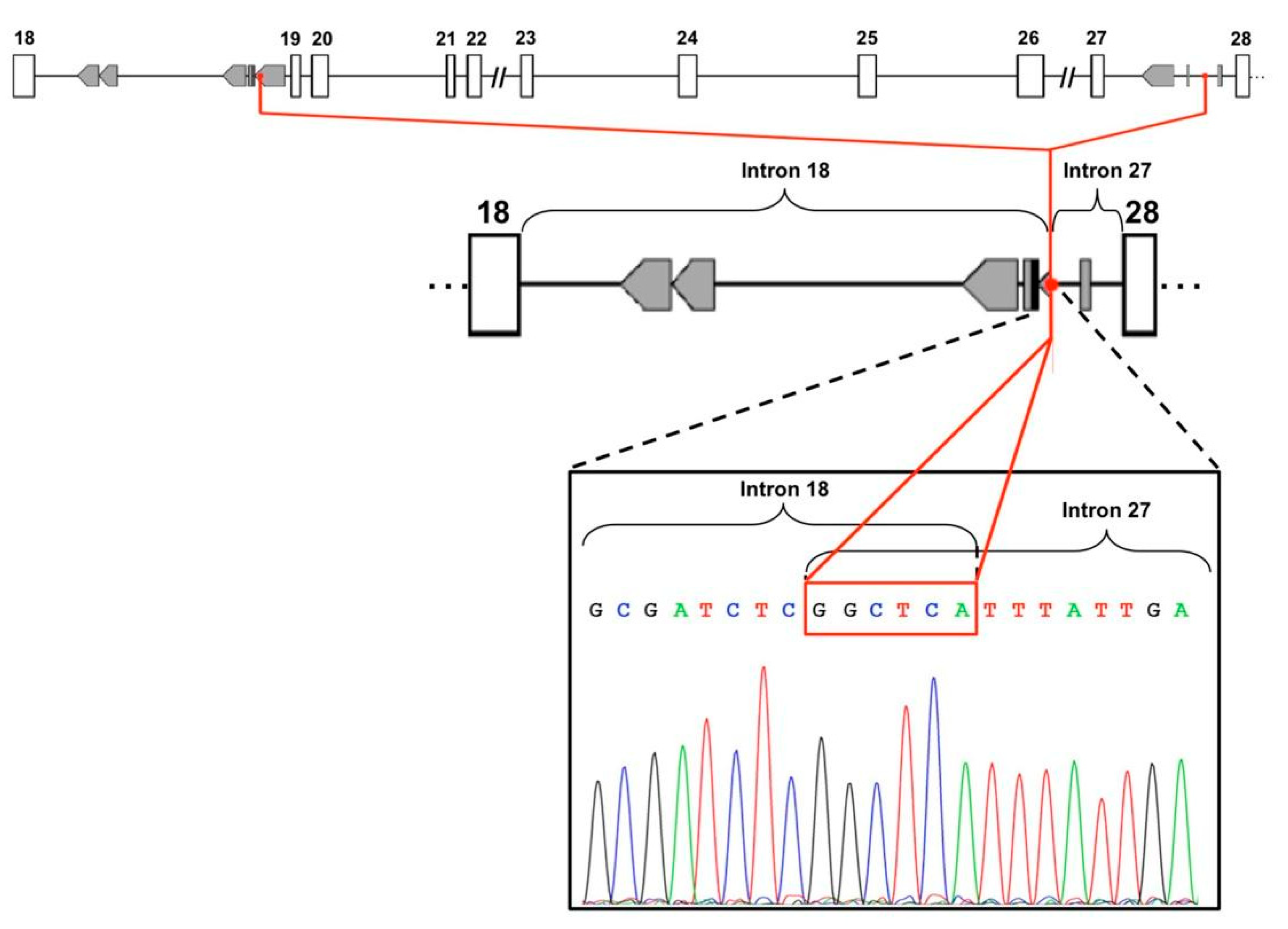Characterization of New ATM Deletion Associated with Hereditary Breast Cancer
Abstract
:1. Introduction
2. Materials and Methods
2.1. Subjects
2.2. NGS Sequencing
2.3. Multiplex Ligation-Dependent Probe Amplification (MLPA) Analysis
2.4. Long-Range PCR of the Gene Region Including the Deletion
2.5. Characterization of the Deletion Breakpoint
2.6. Analysis of ATM mRNA
3. Results
3.1. Identification of Genomic Variant by NGS Analysis
3.2. MLPA Analysis and Breakpoint Characterization
3.3. Characterization of the mRNA Sequence
4. Discussion
Supplementary Materials
Author Contributions
Funding
Institutional Review Board Statement
Informed Consent Statement
Conflicts of Interest
References
- Harbeck, N.; Penault-Llorca, F.; Cortes, J.; Gnant, M.; Houssami, N.; Poortmans, P.; Ruddy, K.; Tsang, J.; Cardoso, F. Breast cancer. Nat. Rev. Dis Primers 2019, 5, 66. [Google Scholar] [CrossRef] [PubMed]
- Neben, C.L.; Zimmer, A.D.; Stedden, W.; van den Akker, J.; O’Connor, R.; Chan, R.C.; Chen, E.; Tan, Z.; Leon, A.; Ji, J.; et al. Multi-Gene Panel Testing of 23,179 Individuals for Hereditary Cancer Risk Identifies Pathogenic Variant Carriers Missed by Current Genetic Testing Guidelines. J. Mol. Diagn. 2019, 21, 646–657. [Google Scholar] [CrossRef] [PubMed] [Green Version]
- Susswein, L.R.; Marshall, M.L.; Nusbaum, R.; Vogel Postula, K.J.; Weissman, S.M.; Yackowski, L.; Vaccari, E.M.; Bissonnette, J.; Booker, J.K.; Cremona, M.L.; et al. Pathogenic and likely pathogenic variant prevalence among the first 10,000 patients referred for next-generation cancer panel testing. Genet. Med. 2016, 18, 823–832. [Google Scholar] [CrossRef] [PubMed] [Green Version]
- Crawford, B.; Adams, S.B.; Sittler, T.; van den Akker, J.; Chan, S.; Leitner, O.; Ryan, L.; Gil, E.; van’t Veer, L. Multi-gene panel testing for hereditary cancer predisposition in unsolved high-risk breast and ovarian cancer patients. Breast Cancer Res. Treat. 2017, 163, 383–390. [Google Scholar] [CrossRef] [PubMed] [Green Version]
- Cobain, E.F.; Milliron, K.J.; Merajver, S.D. Updates on breast cancer genetics: Clinical implications of detecting syndromes of inherited increased susceptibility to breast cancer. Semin. Oncol. 2016, 43, 528–535. [Google Scholar] [CrossRef] [PubMed]
- Choi, M.; Kipps, T.; Kurzrock, R. ATM Mutations in Cancer: Therapeutic Implications. Mol. Cancer Ther. 2016, 15, 1781–1791. [Google Scholar] [CrossRef] [PubMed] [Green Version]
- Renault, A.L.; Mebirouk, N.; Fuhrmann, L.; Bataillon, G.; Cavaciuti, E.; Le Gal, D.; Girard, E.; Popova, T.; La Rosa, P.; Beauvallet, J.; et al. Morphology and genomic hallmarks of breast tumours developed by ATM deleterious variant carriers. Breast Cancer Res. 2018, 20, 28. [Google Scholar] [CrossRef] [PubMed] [Green Version]
- Jerzak, K.J.; Mancuso, T.; Eisen, A. Ataxia-telangiectasia gene (ATM) mutation heterozygosity in breast cancer:A narrative review. Curr. Oncol. 2018, 25, e176–e180. [Google Scholar] [CrossRef] [PubMed] [Green Version]
- Marabelli, M.; Cheng, S.C.; Parmigiani, G. Penetrance of ATM Gene Mutations in Breast Cancer: A Meta-Analysis of Different Measures of Risk. Genet. Epidemiol 2016, 40, 425–431. [Google Scholar] [CrossRef] [PubMed] [Green Version]
- Vignudelli, T.; Selmi, T.; Martello, A.; Parenti, S.; Grande, A.; Gemelli, C.; Zanocco-Marani, T.; Ferrari, S. ZFP36L1 negatively regulates erythroid differentiation of CD34+ hematopoietic stem cells by interfering with the Stat5b pathway. Mol. Biol. Cell 2010, 21, 3340–3351. [Google Scholar] [CrossRef] [PubMed] [Green Version]
- Marino, M.; Rabacchi, C.; Simone, M.L.; Medici, V.; Cortesi, L.; Calandra, S. A novel deletion of BRCA1 gene that eliminates the ATG initiation codon without affecting the promoter region. Clin. Chim. Acta. 2009, 403, 249–253. [Google Scholar] [CrossRef] [PubMed]
- Shafman, T.; Khanna, K.K.; Kedar, P.; Spring, K.; Kozlov, S.; Yen, T.; Hobson, K.; Gatei, M.; Zhang, N.; Watters, D.; et al. Interaction between ATM protein and c-Abl in response to DNA damage. Nature 1997, 387, 520–523. [Google Scholar] [CrossRef] [PubMed]
- Weber, A.M.; Drobnitzky, N.; Devery, A.M.; Bokobza, S.M.; Adams, R.A.; Maughan, T.S.; Ryan, A.J. Phenotypic consequences of somatic mutations in the ataxia-telangiectasia mutated gene in non-small cell lung cancer. Oncotarget 2016, 7, 60807–60822. [Google Scholar] [CrossRef] [PubMed] [Green Version]
- Kozlov, S.V.; Graham, M.E.; Jakob, B.; Tobias, F.; Kijas, A.W.; Tanuji, M.; Chen, P.; Robinson, P.J.; Taucher-Scholz, G.; Suzuki, K.; et al. Autophosphorylation and ATM activation:Additional sites add to the complexity. J. Biol Chem 2011, 286, 9107–9119. [Google Scholar] [CrossRef] [PubMed] [Green Version]



Publisher’s Note: MDPI stays neutral with regard to jurisdictional claims in published maps and institutional affiliations. |
© 2021 by the authors. Licensee MDPI, Basel, Switzerland. This article is an open access article distributed under the terms and conditions of the Creative Commons Attribution (CC BY) license (http://creativecommons.org/licenses/by/4.0/).
Share and Cite
Parenti, S.; Rabacchi, C.; Marino, M.; Tenedini, E.; Artuso, L.; Castellano, S.; Carretta, C.; Mallia, S.; Cortesi, L.; Toss, A.; et al. Characterization of New ATM Deletion Associated with Hereditary Breast Cancer. Genes 2021, 12, 136. https://doi.org/10.3390/genes12020136
Parenti S, Rabacchi C, Marino M, Tenedini E, Artuso L, Castellano S, Carretta C, Mallia S, Cortesi L, Toss A, et al. Characterization of New ATM Deletion Associated with Hereditary Breast Cancer. Genes. 2021; 12(2):136. https://doi.org/10.3390/genes12020136
Chicago/Turabian StyleParenti, Sandra, Claudio Rabacchi, Marco Marino, Elena Tenedini, Lucia Artuso, Sara Castellano, Chiara Carretta, Selene Mallia, Laura Cortesi, Angela Toss, and et al. 2021. "Characterization of New ATM Deletion Associated with Hereditary Breast Cancer" Genes 12, no. 2: 136. https://doi.org/10.3390/genes12020136
APA StyleParenti, S., Rabacchi, C., Marino, M., Tenedini, E., Artuso, L., Castellano, S., Carretta, C., Mallia, S., Cortesi, L., Toss, A., Barbieri, E., Manfredini, R., Luppi, M., Trenti, T., & Tagliafico, E. (2021). Characterization of New ATM Deletion Associated with Hereditary Breast Cancer. Genes, 12(2), 136. https://doi.org/10.3390/genes12020136





